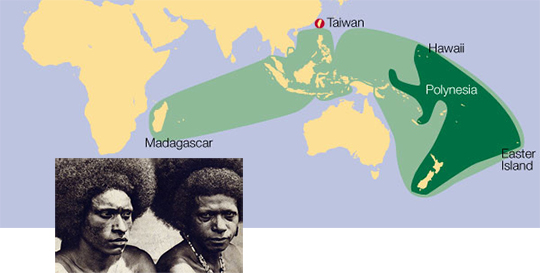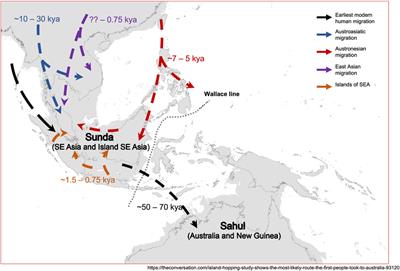For many years the author has been tracking the spread of the Neolithic of Island Southeast Asia ISEA and its extension eastwards into the western Pacific as a proxy for dating the spread of the Austronesian AN languages across that same vast area. Make a copy Learn about Prezi.

New Thoughts On The Out Of Taiwan Theory Archaeology Magazine
Linguistic paleontology and migration theory.

Evidence of austronesian migration theory. Teorya Ng Austronesian Migration. Bellwood et al 2004 states that prior to 3700 BP 1750 BC there is no evidence of any human population in Batanes and that it was only after this period 3700-2700 BP that there were prolific evidences of Neolithic settlement from Eastern Taiwan contrary to what he stated earlier that 2500 BC one group of these Austronesian speakers sailed south to the northern. Perspectives from the peuffffablanca cave sites In the northern Philippines interaction between the foragers of the Peuffffablanca cave sites and the early Austronesian farmers of the Cagayan Valley northern Luzon was established by at least 3500 years ago.
It was a theory proposed by Peter Bellwood a professor of Archeology. Migration Theory and its Evidences Years ago the debate between the origin of. Here he recalls the evidence updates the hypothesis and poses some new questions.
The early austronesian migration to luzon. The long-established theory - based on archaeological linguistic and genetic evidence - is that the development of rice farming in mainland China spread to Taiwan where the languages later known. For evidence that the Austronesians reached the coasts of South America scientists tracked the journey of the sweet potato from Taiwan although this evidence not conclusive.
Peter Bellwoods Out -of-Taiwan hypothesis is generally more dominant and accepted model of the Neolithic Austronesian migration. Excavations across the islands have also uncovered similar pottery styles and stones that originate from Taiwan providing further evidence for the theory. The theory largely explains the similarities in culture language and physical attributes in different countries in the most Asian countries.
A 2021 genetic study which examined representatives of 115 indigenous communities found evidence of at least five independent waves of early human migration. The claim for an Austronesian migration is not a bottom up hypothesis that is the logical upshot of mounting empirical evidence in its favor. Quite the reverse it is chiefly a top down proposition about the facts of the matter whatever one takes the facts to be.
They also include indigenous ethnic minorities in Vietnam Cambodia Myanmar Thailand Hainan the Comoros and the Torres Strait Islands. Negrito groups divided between those in Luzon and those in Mindanao may come from a single wave and diverged subsequently or through two separate waves. The Austronesian languages ˌ ɔː s t r ə ˈ n iː ʒ ən are a language family widely spoken throughout Maritime Southeast Asia Madagascar the islands of the Pacific Ocean and Taiwan by Taiwanese indigenous peoplesThere are also a number of speakers in continental Asia.
Austronesian-speakers live west of a line drawn north-south at about 130 east longitude extending from just west of the Caroline Islands to just east of the Birds Head on the island of New Guinea. A holistic picture of Austronesian migrations revealed by phylogeography of Pacific paper mulberry Chi-Shan Chang 張至善a1 Hsiao-Lei Liu 劉筱蕾b1 Ximena Moncadac Andrea Seelenfreundd Daniela Seelenfreunde and Kuo-Fang Chung 鍾國芳b2 aDepartment of Natural Resources and Environmental Studies National Dong Hwa University Shoufeng Hualien. The dispersal and expansion of this population from southern China.
The Austronesian migrations began from the Chinese mainland reaching Taiwan first in 3500 BC then the Philippines by 3000 BC. There are two main means by which the homeland of the Austronesian language family has been located. The nations and territories predominantly populated by Austronesian-.
View Austronesiandocx from DSS HIST 1 at University of the Philippines Los Baños. The Wave Migration Theory is arguably the most widely known of the prehistoric theories of population development in the Philippines. The question of Austronesian origin and early expansion is related to factors of population growth and instability promoted by agriculture based mainly on cere als rice and probably millet.
This theory which basically says that the homeland of the Austronesian people is the Philippines was put forward by the Principalia Hereditary Council of the P. I have repeatedly argued Terrell 1990 1996 2003 that it is more a good. Throughout numerous evidences on the archaeological linguistic biogeographical and others one of the prominent examples of specimens cited would be the lapita pottery complex which have been described in relation to migration in that the lapita culture represents the austronesian-speaking neolithic populations that colonized oceania.
They are spoken by about 386 million people 49 of the world populationThis makes it the fifth. The Austronesian peoples sometimes referred to as Austronesian-speaking peoples are a large group of peoples in Taiwan Maritime Southeast Asia Micronesia coastal New Guinea Island Melanesia Polynesia and Madagascar that speak Austronesian languages. Created by Henry Otley Beyer founder of the Anthropology Department of the University of the Philippines the theory draws on his expertise of the history of the archipelago and has gone on to influence the theories of a new generation of.
Research on the Lapita pottery dispersal patterns linguistic data human DNA animal DNA and ocean voyaging technology. The distribution of these languages over the Austronesian-speaking area is however relatively more even with. The first of these is an approach to culture history that was pioneered by Pictet Saussure 19151959 Blust 1985.
There is no archaeological or linguistic evidence which allows us to posit trade as a major factor in the early days of Austronesian. The sources of evidence covered include.

Frontiers The Peopling And Migration History Of The Natives In Peninsular Malaysia And Borneo A Glimpse On The Studies Over The Past 100 Years Genetics
Komentar